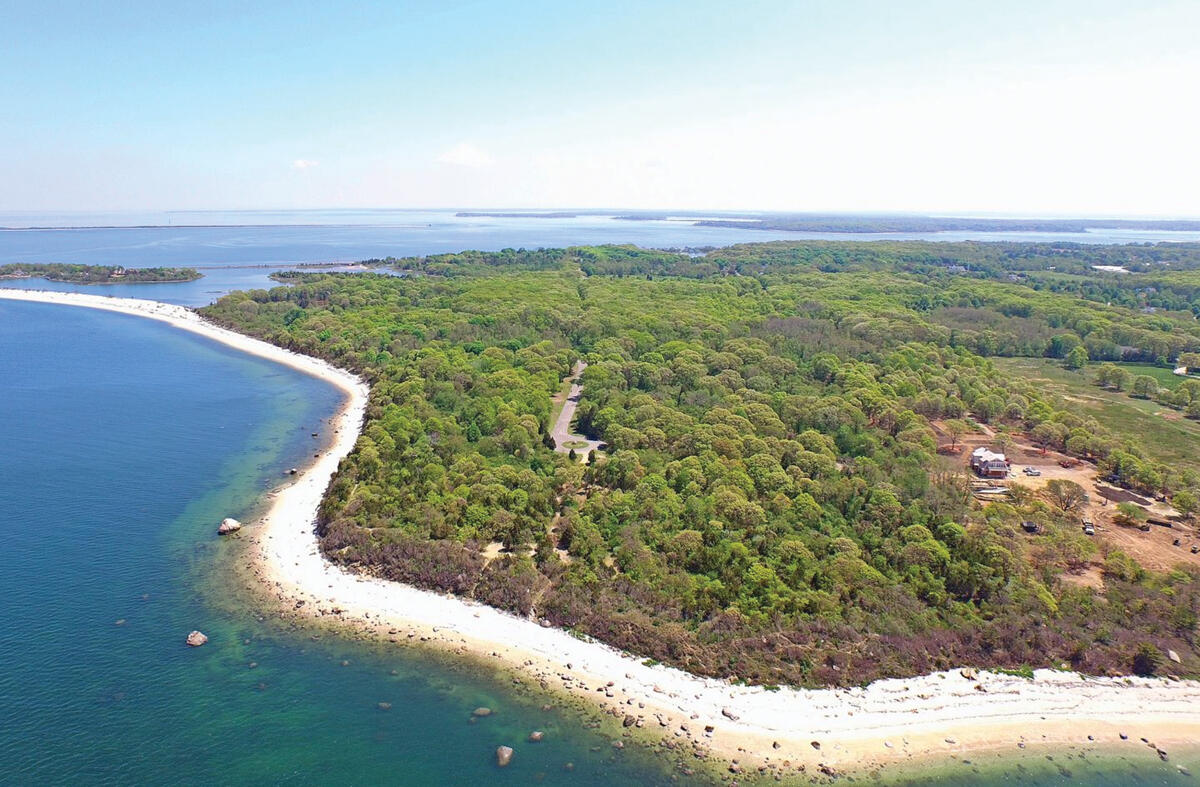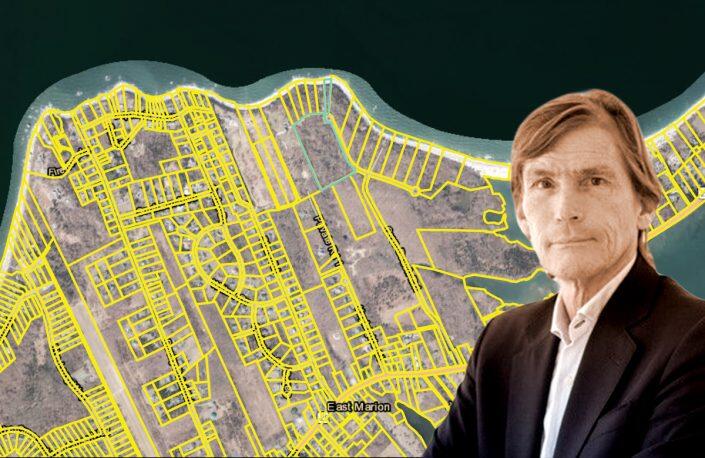 Rare vintage: Long Island’s oldest winery hits the market
Rare vintage: Long Island’s oldest winery hits the market
Trending
The land that time forgot: A North Fork real estate saga
Raoul Witteveen was poised to turn a secluded parcel into an enclave of waterfront estates. Then, mysteriously, he stopped

It’s easier to spot open real estate from thousands of feet above. Just ask Enzo Morabito.
Back in the early 1990s Morabito was scouring the entire East End for his clients, among them Annie Leibovitz, who was looking to buy on the waterfront. Google Earth was still just an idea on a Silicon Valley whiteboard, so to get a clearer view of their options, Morabito and the famed photographer took to the sky.
Morabito hired a single-engine plane and trailed the coastline, tax map in hand. Speeding over Southold, a placid town on the eastern tip of Long Island’s North Fork, the pair barreled right into their dreams. Almost 100 acres of lush, undeveloped forest stretched up to the coast beneath them.
It’s rare to find a single vacant lot in East Marion, the hamlet in Southold he had spotted. This was a different beast. Just below, Morabito saw rare maritime red cedar forests and oak hickories, salt shrubs and coastal marshes. Buffleheads and horned grebes bobbed on its waters. The Long Island Sound ran undisturbed for hundreds of feet along the forest, with a smooth-pebble beach in between.
“What the hell is that?” Morabito wondered.
He had stumbled upon the stretch of land now known as Cove Beach Estates, a verdant patch of wilderness just a two-hour drive from New York City. He and Leibovitz were entranced. When they looked further into the property, they learned it was in foreclosure. Leibovitz wanted in, but Morabito cautioned against it. “We don’t wanna get involved with this,” he said. “It could go on forever.”
Prescient words, it turned out. Almost 30 years later, the property remains practically untouched.
His client passed on the property, but Morabito would be back. He wasn’t done with Cove Beach just yet.
East Marion is a 2-square-mile knuckle of green abutting the fingertip of the North Fork. The hamlet is like a caricature of its sleepy parent, Southold Town. Its business district, if one can call it that, has all the trappings of small-town Americana — white clapboard chapel, white clapboard post office, white clapboard fire department, a general store … and precious little else. The residents like it that way.
For a wooded plot of land, Cove Beach Estates has worn many hats. In 1893, a prominent Southold family sold the property to St. Thomas Episcopal Church from the Upper East Side of New York. The group opened a summer camp on the grounds, welcoming tenement children to wander in nature for two to four weeks, free from the city’s soot and squalor.
The camp replaced a fresh air program in which the church sent kids to farms. That arrangement had been “less satisfactory,” according to a church yearbook, as farmers interpreted the exchange as a “business transaction,” said Ellen Zimmerman, a real estate salesperson for Sotheby’s and vice president of the Oysterponds Historical Society, at a recent seminar about Cove Beach.
Freed from working the fields and wandering the streets, the children traveled to East Marion each summer, first by horse and buggy and later by the Long Island Rail Road. It was an instant success. St. Thomas soon expanded the development, adding a chapel, a washhouse and bathing pavilions by the Sound.
By 1925, though, the summer camp had fallen into disrepair. It no longer met town code, and its “sanitary arrangements [were] primitive,” according to the church yearbook. St. Thomas reluctantly sold it.
“We do not know at this writing where we shall go for these much needed and most beneficial vacations this coming summer; but we do know what a boon this work of the parish is to hundreds of children and working mothers who otherwise would have no summer respite and relief,” read the report.
In the following decades, the property was in turn a gravel pit; a listening post to detect German submarines; a planned ferry station to connect East Marion to Connecticut; and — most famously — a prospective homestead planned, but never built, by Billy Joel and Christie Brinkley.
Joel purchased roughly 70 acres, including the waterfront parcels, in March of 1985, at the outset of his nine-year marriage to Brinkley. Later that year, Joel’s lawyer said the singer was considering several options for the property. But he never filed plans with Southold Town. In December 1986, less than two years after buying in, Joel sold to developer Harold Reese.
While Joel was plotting his exit from Cove Beach, his neighbors took a crack at developing it. Working at times to build anywhere from six to 12 homes on their plots adjacent to Dam Pond, Andrew and Bernice Lettieri spent more than a decade pitching what they called a “mini-estate” to the town board.
But every time the board reviewed their applications, something got in the way: a proposed access road flooded; locals complained they would lose a beloved natural vista; the state objected to the project’s environmental impacts. After years of delays and hundreds of pages of plans and permit filings, the couple withdrew their proposal in 1999.
Once again, Cove Beach stayed wild.

Raoul Witteveen sold four of his rectangular plots on the Long Island Sound years ago. Nine remain unlisted — and all 10 are untouched.
Just a couple of years after his fly-by, Morabito returned. This time, he represented a new wealthy buyer, Dutch businessman Raoul Witteveen. The two rode out to the property in Morabito’s Jeep and inspected the land. “Who owns a half a mile of beach? You can’t even do that on a deserted island,” Morabito told his client.
Southold had its own ideas for the 98 acres. In 1989, town officials asked the Peconic Land Trust to craft a plan to conserve the property, even though they had already granted conditional approval to a previous owner for a 36-home development. That plan fell through, like all the others, but one of the land trust’s conservation ideas endured. Rather than buy Cove Beach, the group would pursue conservation easements from its owner. All it needed was a green-minded benefactor.
A co-founder of Laaken Asset Management, Witteveen sits on the Ocean Council of Oceana, a group that advocates for the protection and restoration of oceans around the world. When he began to consider purchasing the Cove Beach Estates property, Witteveen was taken by its natural beauty, says Morabito. “We spent many nights there by the fire, spearing fish,” the broker says, comparing the scene to Salvador Dali’s frenetic oil painting “Tuna Fishing.”
In June 1994, Witteveen started acquiring land for an assemblage at Cove Beach. He began with a 96-acre parcel, purchased for a reported $2.3 million. Almost immediately, he granted substantial conservation easements to the Peconic Land Trust, starting with a 36-acre plot in 1995. By 1998, Witteveen had given the nonprofit control of 69 acres, including a prime parcel fronting Long Island Sound and Dam Pond. He also pared the planned development from 36 homes to 10. The new plan preserved the interior and pond frontage while retaining a series of 2-acre, Sound-facing parcels with beach access for eventual development.
Read more
 Rare vintage: Long Island’s oldest winery hits the market
Rare vintage: Long Island’s oldest winery hits the market
In August 2004, Witteveen sold the first of those parcels for $1.35 million to Hugh Switzer, a business executive from Atlanta, public records show. A month later, he got $1.1 million for a 4-acre plot. The 2.7 acres adjacent to Switzer’s sold to Henry Mazzoni of Queens for $1.7 million in 2006. The following year, Witteveen unloaded 2.6 acres for $1.9 million.
With four sales done and $6 million pocketed, Witteveen was on the cusp of realizing his vision. He had exquisitely located plots of land, with pristine beach and undisturbed woodlands on either side, buffered by a preserve permanently off limits to development. Interest from well-heeled weekenders was strong.
Then the housing market crashed. Buyers all but disappeared. Aside from a secondary sale in 2010, not a single lot in the subdivision has changed hands since.
Just as remarkable, although Cove Beach Estates has a cove and a beach, it still has no estates. In 2010, Mazzoni, the owner of the 2.7-acre plot, received permission from the Southold board to clear up to 50 feet inland from the beach and construct a two-story home. Although the permits have since expired, Mazzoni reapplied in May 2021 to build the home and remains in negotiations with the town. He declined to comment.
Instead of the dream homes Witteveen imagined, visitors today find only an asphalt access road — with chest-high weeds somehow sprouting directly from the pavement — and a few overgrown utility stanchions, some covered in graffiti and all in various states of disrepair.
Actually, about a 30-second walk from the bluff overlooking the Sound, there is one structure — an abandoned, oversized cabin, its double doors stuck in the open position. In front of it, empty beer cans and bottles litter the remnants of a firepit. This may be what remains of the summer camp.
For the pleasure of owning such treasures, Witteveen was billed for more than $45,000 in real estate taxes last year, town records show. Not one of his six remaining parcels is advertised for sale.
One of the four he sold is listed for $1.85 million, but it has been on the market for more than two years. Marie Beninati, the agent for the property, did not respond to repeated requests for comment.
Nine in 10 East Marion houses are single-family, detached units, and the vast majority cost between $500,000 and $1 million, according to census data. But that could be changing.
Once a salty farming enclave, East Marion has not been spared from the scant inventory and rising prices pressuring homebuyers — and delighting sellers — across the country. In May, the average house sale price in Southold had risen $50,000 in just six months, according to data from Daniel Gale Sotheby’s International Realty. And the annual increase has grown each month, from 22 percent in January to nearly 50 percent in May. It is an acceleration of a long trend interrupted briefly by the Great Recession: From 1990 to 2005, single-family homes in Southold tripled in price.
For a lightly populated area, the North Fork has surprisingly little buildable land. East Marion preserves much of its acreage as open space, both through its zoning code and the Peconic Bay Region Community Preservation Fund. The fund, which collects a 2 percent tax on real estate purchases, pulled in more than $7.5 million in 2019, according to its most recent audit. It spent $13 million on land acquisitions that year. In all, the fund has preserved over 10,000 acres and controls $124 million worth of land and development rights.
Even those who own vacant land in East Marion have their hands tied. The maximum lot coverage for new residential homes is 20 percent, meaning a house can only occupy a fifth of the land on which it sits. It can’t be taller than 35 feet, or 2.5 stories, without a variance.
While Cove Beach Estates remains undeveloped, the rest of the North Fork housing market is bustling like never before.
“It’s the busiest I’ve ever seen it,” said Robert Gabrielsen of Gabrielsen Builders, which has constructed custom homes there since 1975. His company, while battling the same supply shortages as other builders nationwide, has seen business jump not only in new builds but in renovations.
The renovations help because almost all of the land to be spoken for in East Marion already has been. “It’s rare there’s just a lot sitting there,” said Gabrielsen. “You just can’t find land out here like you used to.”
While the market dynamics point toward developing homes on Cove Beach, Witteveen, who declined to comment for this article, may have other ideas. “We would love to see it turn into a park — it’s a natural park already,” said Morabito.
That is not out of the realm of possibility, given Witteveen’s environmental affiliations, his past grants to the Peconic Land Trust and the fact that he has already turned a profit on his purchase. “We would welcome further conservation in the area, and are ready to work with landowners and the town when appropriate,” said Yvette Debow-Salsedo, the vice president of the Trust.
The Community Preservation Fund is flush with cash and eager to buy any land it can. Witteveen might own some of the last developable land in East Marion, but he also might not care. A quarter century after he first set eyes on it, Cove Beach remains wild.




